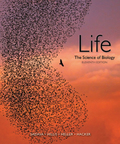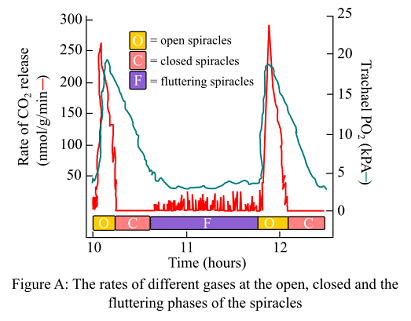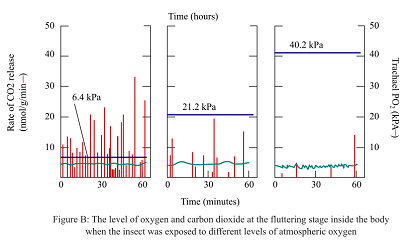
Concept explainers
To analyze:
The variations in Po2 (in units of mmHg) in a typical open-close-fluttering cycle. Also explain the estimated mm Hg Po2 in the atmosphere and inside the tubes of trachea in all the three given experiments shown in figure B. Here, 1 kPa (kilopascal) = 7.5 mm Hg.
Given information:
The microscopic plastic tubes were inserted into the tracheae of the pupae of Attacus atlas moths by the researchers to study the tracheal function in the moths. The microtubes were attached to the sensors for recording the rate of CO2 that was released from the tracheae and also the intratracheal concentrations of O2.
The pupae were placed in the chambers by the researchers and the normal atmospheric levels of the gases were maintained. Researchers then recorded the behavior of spiracles, rate of CO2 release, and O2 concentrations in the tracheae. The results are shown in figure A.
In order to examine the spiracles performance in the different atmospheric conditions and their effects on the rate of CO2 release and O2 concentrations, pupae were exposed to the different levels of atmospheric O2. The levels of the release of CO2 and O2 concentrations were calculated during the fluttering stage as shown in the figure B.


Introduction:
The insectys have a unique mechanism of air exchange in their bodies. The respiratory system of the insects consists of the tracheae that is responsible for the gaseous exchange in and out of tissues. There are spiracles present that guards the trachea. They are valve-like and either remains open, closed, or in a fluttering state.
Explanation of Solution
Intratracheal partial pressure of O2 during the open phase of the spiracles in the tracheae as shown in the figure is 20.4 kPa.
If 1 kPa = 7.5mm Hg, then, Po2 during the open phase will be,7.5*20.4 = 153 mm Hg.
During the closed phase, Po2 decreases to 4–5 kPa.
If 1 kPa = 7.5mm Hg, then, PO2 during the closed phase will be,7.5*5 = 37.5 mm Hg.
During the fluttering phase, if the oxygen concentration is changed as shown in figure B, the PO2 will be calculated as
Case1, If 1 kPa = 7.5mm Hg, 7.5*6.4 = 48 mm Hg.
Case2, If 1 kPa = 7.5mm Hg, 7.5*21.2 = 159 mm Hg.
Case3, If 1 kPa = 7.5mm Hg, 7.5*40.2 = 301.5 mm Hg.
Thus, it can be concluded that the changes in approximate mm Hg of PO2 in a typical open-close fluttering cycle are 153 mm Hg and 7.5 mm Hg during the open and closed phases, respectively. Also, in the tubes of the trachea, in all the three given cases, the pressure was 48 mm Hg, 159 mm Hg, and 301.5 mm Hg, respectively.
Want to see more full solutions like this?
Chapter 48 Solutions
EBK LIFE: THE SCIENCE OF BIOLOGY
- Which option best describes the following figure? Y (fraction saturation) 1.0 0.8 0.6 0.4 0.2 0.0 0 20 Oxygen Binding plot 40 60 p02 (torr) 80 100 A) Curve x = adult haemoglobin, curve y = fetal haemoglobin B) Curve x = myoglobin, curve y = haemoglobin C) Curve x = fetal haemoglobin, curve y = adult haemoglobin D) Curve x = fetal haemoglobin, curve y = myoglobin E) Curve x = adult haemoglobin, curve y - myoglobinarrow_forwardPrecise data have been obtained for the oxygen binding of stripped human hemoglobin at 25 °C: Poz (mm Hg) Poz (= 100 x Yo,) (mm Hg) % Saturation % Saturation (= 100 × Y) 0.10 0.315 5.75 76.0 0.350 0.990 7.94 90.9 0.794 3.06 12.88 96.9 1.748 9.09 29.51 99.0 2.884 24.0 67.60 99.7 4.467 50.0arrow_forwardIdentify the factors that shift the oxyhemoglobin dissociation curve to the right?arrow_forward
- Using a cardiac output (CO) of 5 L/min, compare the rate of O2 delivery to the systemic cells with and without hemoglobinarrow_forwardp02 Y O2 (mmHg) 0.5 0.161 1 0.277 0.434 3 0.535 4. 0.605 0.697 0.754 12 0.821 20 0.885 Using the data provided in the table, the estimated p50 for myoglobin is mmHg and the fraction saturation of myoglobin at 30mmHg is 6arrow_forwardTo assess for the co-transduction of Leu+ and Arg+, what would need to be added to the minimal media?arrow_forward
- What will be the effective permeability coefficient ko for oxygen transport from alveoli to the surface of red blood cells provided the tissue between alveoli and pulmonary vessels has permeability to oxygen Pw = 0.3cm/s, while the mass transfer coefficient for oxygen transport in blood plasma km = 0.5cm/s? Select an answer and submit. For keyboard navigation, use the up/down arrow keys to select an answer. a 0.8 cm/s b. 0.75cm/s 2 0.19 cm/s - 0.05 cm/sarrow_forwardThe below graph shows changes in several cardiovascular parameters as the result of increased intensity of exercise in a population of untrained individuals. What commonly measured cardiovascular parameters might the curves labeled A, B, and C represent? What are the corresponding units for the y-axis of each measure? For your reference, the two labeled curves represent the Pulmonary Capillary Wedge Pressure (PCWP) and the Central Venous Pressure (CVP), both of which are measured in mmHg.arrow_forwardThe arterial O₂ concentration is given by the following expression [0₂] = 0.003 P0₂ + (PO₂)².8 +(26) 2.8 1. ЗЧНЬ (Рог ) 2-8 Where Poz is the alveolar O₂ pressure and Hb is the hemoglobin concentration in g/dL, respectively A subject who is at 0-95 ATM (211-0₂) has an arterial O₂ concentration of 19ml/dL and and arterial CO₂ pressure of 38mm Hg. Also, VO₂ = 340mL/min.; VCD₂ = 289 mL/min. Therefore, your hemoglobine level is: A. 14.39 Idl 8. 14.8 g/dl C. 15.2 g/dl D. 15.7g/dL E. 16 g/dLarrow_forward
- Calculate the fractional saturation for hemoglobin when the partial pressure of oxygen is 80 mm Hg. Assume hemoglobin is 50% saturated with oxygen at a partial pressure of 24 mm Hg and that the Hill coefficient is 3.arrow_forwardReaction paper about Effects of Synchronization during Noninvasive Intermittent Mandatory Ventilation in Preterm Infants with Respiratory Distress Syndrome Immediately after Extubation.arrow_forwardWhat formula could we use to calculate the rate of respiration in this experiment. Select all that apply: Change in O_2O2 / Change in Time Change in Time / Change in O_2O2 Change in CO_2CO2 / Change in Time Change in Time / Change in O_2O2arrow_forward
 Human Physiology: From Cells to Systems (MindTap ...BiologyISBN:9781285866932Author:Lauralee SherwoodPublisher:Cengage LearningCase Studies In Health Information ManagementBiologyISBN:9781337676908Author:SCHNERINGPublisher:Cengage
Human Physiology: From Cells to Systems (MindTap ...BiologyISBN:9781285866932Author:Lauralee SherwoodPublisher:Cengage LearningCase Studies In Health Information ManagementBiologyISBN:9781337676908Author:SCHNERINGPublisher:Cengage




